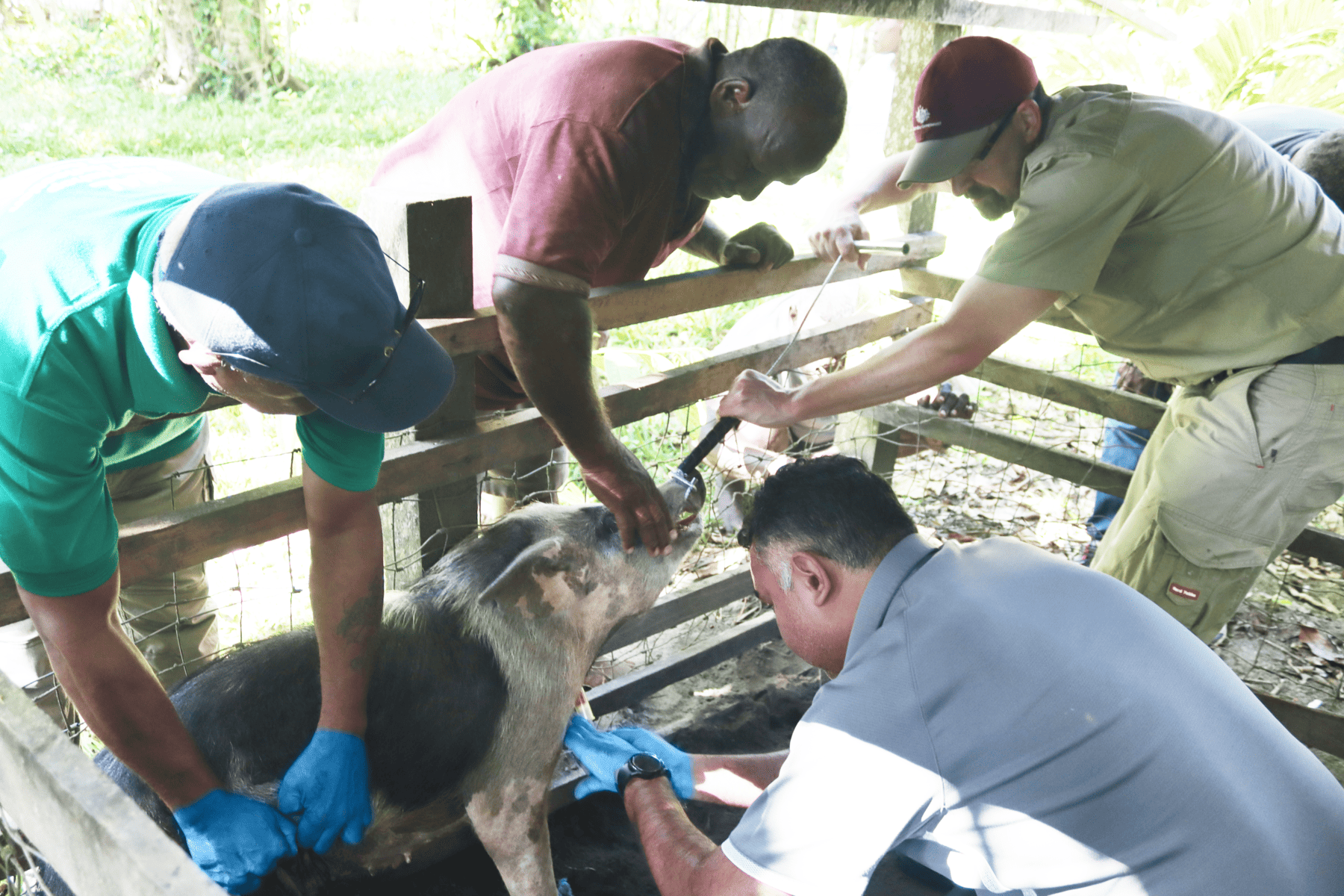Earlier this year, alarming reports came out of Indonesia about an outbreak of Foot and Mouth Disease (FMD). As of 2nd July, Indonesia recorded 313,636 infected cattle, with over 2,700 deaths. [1]
What is FMD?
FMD is a highly contagious disease that affects cloven-foot animals such as pigs, goats, cattle and sheep. FMD is endemic in different parts of the world, including Asia, Africa and the Middle East, and the disease is estimated to circulate in 77 percent of the global livestock population. [2]
“Even though FMD is not present in the Solomon Islands, it poses one of the biggest threats to our cattle industry. The Solomon Islands cattle industry is tiny, and FMD is dangerous enough that if it ever gets in, within days it could spread across farms and diminish the cattle population,” says Rickson Wate, Director of the Solomon Islands Ministry of Agriculture Livestock Department.
FMD and the livestock industry
Livestock production and agriculture have long been the backbone of Pacific livelihoods, fundamental for food security, economy and culture. In addition, it is quite common to raise livestock in rural communities for family events such as funerals, weddings and different traditional occasions. Despite this, livestock production is still a growing industry within the region, and farmers still face barriers to accessing markets due to lack of resources and infrastructure. Recognising these challenges and the potential for livestock to play a growing role in livelihoods and economies, Pacific governments have shown interest in developing the industry and reducing dependency on imported meats.
FMD compromises these efforts and could roll back livestock industry progress, in addition to fracturing food security. The outbreak in Indonesia substantially increases the risk of FMD entering the region. While FMD is not a threat to human health, the impact on animals has severe consequences for the Pacific livestock industry.
Animals infected with FMD become severely ill. Frequent symptoms are fever, depression, hypersalivation, loss of appetite, weight loss, growth retardation and a drop in milk production that can persist even after recovery.[2] According to the World Organisation for Animal Health, chronically affected animals are reported to have an overall milk yield reduction of 80 percent. A typical clinical sign is the occurrence of blisters on the nose, tongue or lips, inside the oral cavity, between toes, above hooves, on teats and at pressure points on the skin.[2]
Countries that are FMD-free have banned meat imports and animal products from affected areas to protect animal health and livestock. This significant disruption of production and trade leads to losses of billions of dollars. For example, Indonesia estimates a loss of USD 6.6 Billion per year due to the disease1.
How is FMD spread?
For the disease to be of such wide concern is no surprise, considering how fast spreading and persistent the virus appears to be. It can be found in infected animals’ secretions and mucus and even breathed out in an aerosolised form. Direct animal contact is the main FMD pathway, and it is commonly spread through movement between farms. The virus hitchhikes on materials used around infected animals, such as farming tools, equipment, clothing and footwear. It can also stubbornly remain in animal meat, feed and livestock products.
How can FMD be prevented?
Good hygiene is critical if there is anything the global population has learned in the last three years as the COVID-19 pandemic spread out to every corner of earth. This holds true for FMD, particularly for anyone that has been around animals, near a farm or rural community. Those that have had contact must wash their hands properly and thoroughly disinfect clothes and boots worn in these areas. Proper cleaning and maintenance of farm tools and equipment can also help prevent FMD from spreading. In addition, travellers, especially those that are around farm animals, are responsible for the communities that they visit and should not bring in dangerous diseases such as FMD. It is crucial that these travellers truthfully declare to biosecurity officials their proximity or contact with animals or a farm.
Response
The Pacific Community (SPC) has launched an awareness campaign to fight foot and mouth disease, urging farmers and related communities to help prevent FMD and increase their knowledge in regard to its detection and treatment.
“There is ongoing work to strengthen biosecurity measures to protect against animal health diseases, and this SPC campaign can help reinforce this work and build a collective sense of ownership to keep the Pacific FMD-free,” says SPC Animal Health and Production Advisor Dr. Sripad Sosale.
The campaign kicked off in the Solomon Islands in October as the SPC team conducted animal disease surveillance work on the livestock population. The work was part of the Safe Agricultural Trade Facilitation through Economic Integration in the Pacific (SAFE Pacific) project funded by the European Union and implemented by SPC’s Land Resources Division (LRD). SAFE Pacific aims to improve regional economic integration through strengthened biosecurity, animal health and production and sustainable agricultural value chains.
The FMD campaign focuses on raising awareness among farmers and travellers on how FMD is spread, prevention measures, and clinical symptoms and reporting pathways. Farmers and community members that suspect FMD are encouraged to contact a local animal health officer or livestock department and report it to the respective national biosecurity agency.
The FMD campaign also stresses the collective responsibility to protect the region. As a critical concern, FMD is one of many animal disease threats that the Pacific must remain vigilant against to sustain its rich biodiversity, culture and livelihoods.
[1] Reliefweb. 2022. Indonesia Foot and Mouth Disease Outbreak. [online] Available at: https://reliefweb.int/report/indonesia/indonesia-foot-and-mouth-disease-outbreak-emergency-plan-action-epoa-dref-operation-ndeg-mdrid024#:~:text=Attachments&text=Indonesia%20has%20been%20struck%20by,and%20227%20districts%20or%20cities. [Accessed 10 October 2022].
[2] WOAH – World Organisation for Animal Health. 2022. Foot and mouth disease – WOAH – World Organisation for Animal Health. [online] Available at: https://www.woah.org/en/disease/foot-and-mouth-disease/#:~:text=FMD%20is%20an%20WOAH%2Dlisted,OIE)%20established%20official%20status%20recognition. [Accessed 10 October 2022].
